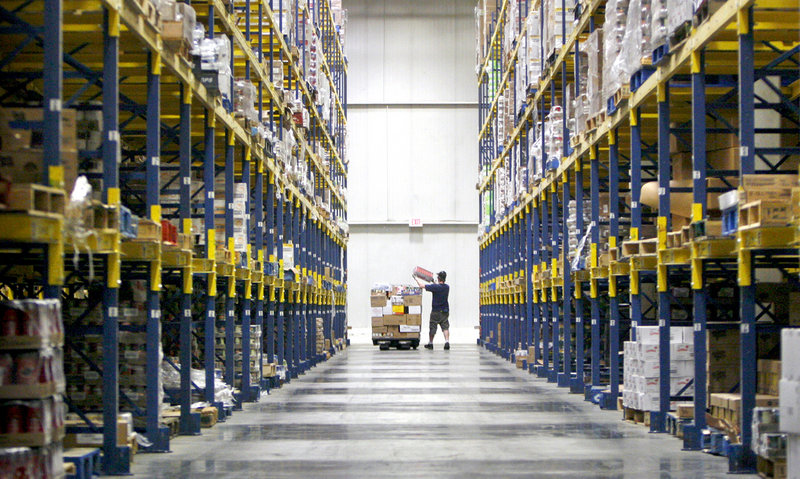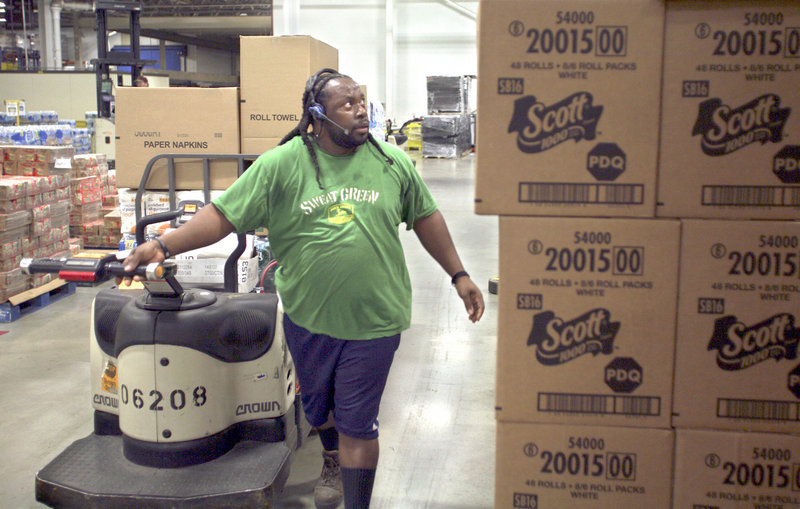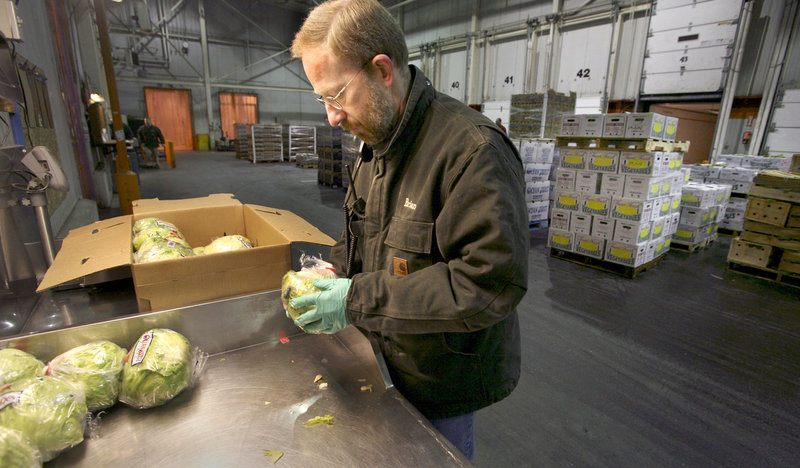SOUTH PORTLAND – If you think the Hannaford checkout line was busy on this Independence Day weekend, consider the distribution center.
The massive South Portland facility hummed with activity last week — one of the company’s busiest — as workers on carts called “double jacks” zipped down aisles filling orders from stores.
They worked fast and efficiently, guided by computer systems that track nearly every step of distribution.
Executives at the Scarborough-based supermarket company say computer systems like those in South Portland have helped Hannaford Bros. Co. return strong financial results in recent years.
And they say other factors, such as a Maine identity and a focus on locally sourced products, have helped Hannaford, which is owned by Belgium-based Delhaize Group, compete in an industry with razor-thin margins.
“Making sure we remain uniquely Hannaford — that’s what I do all day,” said Hannaford President Beth Newlands Campbell. “The board is really interested in growing Hannaford because we’re doing so well. The question they ask me is, ‘How can we grow this company more quickly?’ “
The firm that became Hannaford started in 1883, when Arthur Hannaford began selling fruits and vegetables from a one-horse produce cart on Portland’s waterfront. Roughly 20 years later, Hannaford’s siblings, Howard and Edward, helped incorporate the business.
Hannaford grew into one of the largest produce wholesalers in northern New England by 1920, and in 1939 acquired a grocery wholesaler, H. S. Melcher Co., according to the company’s website.
Hannaford entered the retail business in 1944, when it partnered with Cottle’s Supermarkets, and expanded in northern Maine when it merged with Bangor’s T.R. Savage Co. in 1955.
Hannaford continued growing through acquisitions, and by 1971 had 59 supermarkets in Maine, New Hampshire and Vermont with earnings of more than $1 million. That same year, Hannaford also became publicly traded.
Sales hit $1 billion by 1987, $2 billion by 1992 and $3 billion by 1997. During the 1990s, Hannaford acquired two supermarket companies with operations in the southeast United States.
In 2000, Belgium-based Delhaize — now called Delhaize Group — acquired Hannaford Bros. in a deal valued at $3.6 billion.
178 STORES, FIVE STATES
Hannaford now has 178 stores, operations in five states, some 26,000 workers (including about 9,500 in Maine) and revenue of more than $5 billion, said Newlands Campbell.
Roughly 80 percent of stores have pharmacies, which account for 10 percent of revenue, said spokesperson Michael Norton.
Hannaford’s corporate owner, publicly-traded Delhaize, owns stores in the United States and Europe and employs some 138,600 workers.
In 2010 Delhaize had revenue of 21 billion euro, or $30 billion.
The Delhaize U.S. division reported revenue of $18.8 billion in 2010 and had nearly 104,000 employees from Maine to Florida. The division owned 1,627 stores under brands including Food Lion, Sweetbay Supermarket, Bloom, Bottom Dollar Food and Harveys Supermarket.
Newlands Campbell said corporate ownership has benefits.
She said Delhaize helped Hannaford acquire capital to acquire 19 Victory Supermarkets in 2004. And Hannaford staffers have been given job opportunities with Delhaize in other countries.
The domestic Delhaize brands share some corporate functions; accounting happens at Food Lion’s headquarters in Salisbury, N.C., and human resources is managed in Scarborough.
Newlands Campbell has direct responsibility for one other brand — Bloom, which has 49 stores in the Washington, D.C., region and southeast Virginia.
She also works closely with presidents at other Delhaize brands.
“At the end of the day we are selling groceries and have the same challenges,” she said.
According to the Arlington, Va.-based Food Marketing Institute, there are some 36,000 supermarkets in the United States with annual sales of more than $2 million each. The industry employs some 3.4 million workers and generated 2010 sales of $563 billion.
Many Delhaize competitors are also owned by holding companies. Netherlands-based Ahold, for instance, owns The Stop & Shop Supermarket Co., which is strong in the Northeast, and Giant, which has operations in the mid-Atlantic.
Supervalu Inc., based in Minnesota, owns Shaw’s and others. Publix Super Markets Inc., a major chain in the South, is owned by private investors and employees.
CENTER EMPLOYS 500
Hannaford’s South Portland distribution center, built in the 1960s and expanded multiple times since, employs more than 500 people, including production workers, drivers and contractors, said Bruce Southwick, manager of the distribution plant.
The site receives and ships 1.3 million cases of groceries weekly, and supplies 109 Hannaford stores and 31 independent grocery markets, including Bow Street Market in Freeport and Smaha’s Legion Square Market in South Portland. It operates around the clock.
Inside, workers wearing headsets and small computers on their belts zip down aisles on double jacks, machines that can carry two pallets. An electronic voice from their headsets tells workers which items to pick up and in what order, said Southwick.
For instance, the voice might read “C6009A” — the code printed on a steel beam beside pallets of Campbell’s Cream of Chicken soup. After loading the soup, the workers speak a confirmation number — in this case “76.” Only then will the computer tell them what to get next.
A worker might walk three miles in a shift and lift between 30,000 and 60,000 pounds of groceries, said Southwick. Those who pack orders fastest get extra pay or time off.
The facility has refrigeration rooms for fruits, vegetables, meats, cheeses and other perishable goods.
Another Hannaford distribution site in Schodack, N.Y., supplies stores in New York, Vermont and western Massachusetts, and a smaller warehouse in Winthrop supplies slower-selling items.
Executives say sophisticated, multimillion-dollar computer systems, which took years to build and put into operation, keep distribution running efficiently.
Computers track historic sales trends of all products, taking into account factors like time of year and shelf location, and place orders for stores. They also ensure workers pack orders efficiently and that stores have enough products to stock the shelves, but not too much inventory.
Newlands Campbell said efficiency helps Hannaford compete in an industry with “very small margins.” She said the average supermarket earns $1 to $2 dollars for every $100 in sales.
Hannaford’s distribution processes were adopted by other Delhaize brands, as were some of the computer systems Hannaford developed.
Newlands Campbell said Hannaford performed “incredibly well” financially in recent years. She said same-store sales, an important measure of performance, have been on the rise, thanks in part to innovative programs.
For example, in 2010 the company unveiled a sustainable seafood policy and partnered with fishing boat Captain Linda Greenlaw to sell Greenlaw-branded swordfish.
Hannaford has also been branding some seafood as “Responsibly Harvested” in a program with the Gulf of Maine Research Institute, and it launched Guiding Stars, a program that rates products based on nutritional value.
Newlands Campbell said Hannaford has always bought locally-sourced food, but has been more vocal about local products in recent years.
She said the company will continue to grow through acquisitions and by building new stores, some of which will likely be in Maine. Hannaford opened a new store in Lake Placid, N.Y., in April and five other stores in 2010.
MAINTAINING LOCAL IDENTITY
Newlands Campbell attributes Hannaford’s strength partly to the company’s strong local identity, despite foreign ownership.
She noted that Hannaford and its charitable foundations donate to local nonprofits, including the United Way, community colleges and Portland’s Preble Street social services agency.
“I think what consumers want out of a grocery store is a business that’s not just selling local products, but (that is) connected to the local community,” she said.
Mark Swann, executive director of Preble Street, said he contacted Newlands Campbell in 2010 about a federal anti-hunger program. He needed hundreds of thousands of dollars in private donations quickly in order to qualify for roughly $1.1 million in federal funds.
Hannaford’s foundation donated $170,000, said Swann, and Newlands Campbell helped secure another $100,000 from Kraft Foods’ foundation.
“For me to be able to call the CEO of Hannaford, and for her to come right back and say, ‘How can we help’ — it’s an extraordinary moment,” said Swann.
He added that individual Hannaford stores have given Preble Street enough food to make more than 1 million meals in the last 20 years.
In the group’s fiscal year 2011, Hannaford markets donated 85,000 meals, and just last week Hannaford received Preble’s Community Partner Award.
“They are very tuned into the communities in which they work,” Swann said. “(They are) generous and supportive and intertwined in the fabric of the community.”
Jonathan Hemmerdinger can be reached at 791-6316 or:
jhemmerdinger@mainetoday.com
Send questions/comments to the editors.





Success. Please wait for the page to reload. If the page does not reload within 5 seconds, please refresh the page.
Enter your email and password to access comments.
Hi, to comment on stories you must . This profile is in addition to your subscription and website login.
Already have a commenting profile? .
Invalid username/password.
Please check your email to confirm and complete your registration.
Only subscribers are eligible to post comments. Please subscribe or login first for digital access. Here’s why.
Use the form below to reset your password. When you've submitted your account email, we will send an email with a reset code.